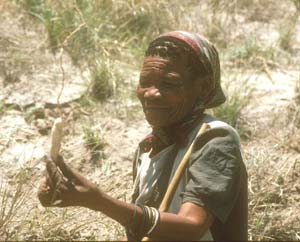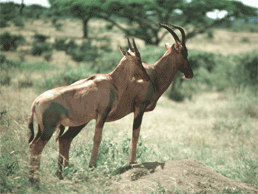|
Photo gallery
 On my first day on the road, I came across this glorious protea not far from Cape Point.
On my first day on the road, I came across this glorious protea not far from Cape Point.
 Hands wave and breasts swing as the women shuffle along to the throbbing, pulsating rhythms that fill the shelter.
Hands wave and breasts swing as the women shuffle along to the throbbing, pulsating rhythms that fill the shelter.
 ... racing forward across the plains, right arm up, stretched back and ready to launch a heavy throwing stick, left arm carried low, thrust forward and holding a small spear or jabbing stick.
... racing forward across the plains, right arm up, stretched back and ready to launch a heavy throwing stick, left arm carried low, thrust forward and holding a small spear or jabbing stick.
 The wonderful baggy elephant. Tons and tons of loose stones and scree are strewn over the slopes at Twyfelfontein. Scattered amongst the debris are huge red boulders that have sheared in half creating perfectly flat and smooth faces that make ideal surfaces for the stone age artists.
The wonderful baggy elephant. Tons and tons of loose stones and scree are strewn over the slopes at Twyfelfontein. Scattered amongst the debris are huge red boulders that have sheared in half creating perfectly flat and smooth faces that make ideal surfaces for the stone age artists.
 ... and scramble up to a large slab of stone that has its smooth broken face lying in a vertical plain, like some stone age cinema. It is covered in a veritable menagerie of rock etchings - giraffe, rhino, lion, wildebeest, warthog, a lizard and a wonderful baggy elephant....
... and scramble up to a large slab of stone that has its smooth broken face lying in a vertical plain, like some stone age cinema. It is covered in a veritable menagerie of rock etchings - giraffe, rhino, lion, wildebeest, warthog, a lizard and a wonderful baggy elephant....
 His legs are long and powerful with large footpads as if he too is a traveller. This is a nomadic lion. (Now sporting a radio collar that will enable scientists to track him when he wanders out of the park and into farmland.)
His legs are long and powerful with large footpads as if he too is a traveller. This is a nomadic lion. (Now sporting a radio collar that will enable scientists to track him when he wanders out of the park and into farmland.)
 Peeping out from a thicket near to the Kavango River was a little pointed face above a fluffy rufous body.
Peeping out from a thicket near to the Kavango River was a little pointed face above a fluffy rufous body.
 Bleeding eck, it's a whale! Stuart Blackman in top form at Tsodilo Hills.
Bleeding eck, it's a whale! Stuart Blackman in top form at Tsodilo Hills.
 On three sides, the Kalahari stretches out to meet the sky in a far-off hazy union and on the fourth lies ‘Female' and ‘Child'. There is a grandeur in these hills but it is harsh, elemental and unforgiving.
On three sides, the Kalahari stretches out to meet the sky in a far-off hazy union and on the fourth lies ‘Female' and ‘Child'. There is a grandeur in these hills but it is harsh, elemental and unforgiving.
 Molapo women foraging for roots and tubers in the Kalahari. It occurs to me that foraging in this meadow is the Stone-Age equivalent of shopping in a supermarket but with a built-in exercise regime.
Molapo women foraging for roots and tubers in the Kalahari. It occurs to me that foraging in this meadow is the Stone-Age equivalent of shopping in a supermarket but with a built-in exercise regime.
 Several false holes are started and abandoned before more tubers, this time smaller and from a different species, are gathered up and stuffed inside their bags.
Several false holes are started and abandoned before more tubers, this time smaller and from a different species, are gathered up and stuffed inside their bags.
 Kisimisi talked of finding up to 100 snares in a day when patrolling along the river and round the pans in the centre of the Sengwa area where I used to study impala.
Kisimisi talked of finding up to 100 snares in a day when patrolling along the river and round the pans in the centre of the Sengwa area where I used to study impala.
 The so-called elephant problem. This photograph taken in the Ngoro-ngoro crater is slightly out of sequence but is included here to illustrate the theme of conflict in modern society that emerges in the middle part of Second Nature.
The so-called elephant problem. This photograph taken in the Ngoro-ngoro crater is slightly out of sequence but is included here to illustrate the theme of conflict in modern society that emerges in the middle part of Second Nature.
 The conflict between elephants and farmers is at its most intense in the Zambezi Valley on the edges of the great Chewore Safari Area. Here the villagers keep a look-out for crop marauders from towers built on termite mounds.
The conflict between elephants and farmers is at its most intense in the Zambezi Valley on the edges of the great Chewore Safari Area. Here the villagers keep a look-out for crop marauders from towers built on termite mounds.
 ... twin ivory tusks cruise slowly and menacingly past Nomad's flimsy window. It reminds me of something - the scene from Jurassic Park when a Tryranosaurus Rex is after those hapless children.
... twin ivory tusks cruise slowly and menacingly past Nomad's flimsy window. It reminds me of something - the scene from Jurassic Park when a Tryranosaurus Rex is after those hapless children.
 Campsite in Mana Pools National Park under an immense fig on the banks of the Zambezi River.
Campsite in Mana Pools National Park under an immense fig on the banks of the Zambezi River.
 ... the river elephants used my camp whenever they pleased.
... the river elephants used my camp whenever they pleased.
 Finally I work it out, the mysterious midnight sounds, Che-sploosh, Che-sploosh Che-sploosh, are hippo feeding on inundated grasses.
Finally I work it out, the mysterious midnight sounds, Che-sploosh, Che-sploosh Che-sploosh, are hippo feeding on inundated grasses.
 The blue sky is reflected in the channels of the Zambezi which wind their way through the sandy, grass-covered bars and islands that each night are grazed short by hippo.
The blue sky is reflected in the channels of the Zambezi which wind their way through the sandy, grass-covered bars and islands that each night are grazed short by hippo.
 On the way to the Olduvai Gorge near to Serengeti National Park, I met up with some young Maasai decked out in ceremonial gear.
On the way to the Olduvai Gorge near to Serengeti National Park, I met up with some young Maasai decked out in ceremonial gear.
 Wildebeest have a nomadic lifestyle, following rain storms to find young nutrient-rich pastures. In the Serengeti-Mara ecosystem they undergo annual migrations, calving on the plains in the south-east which have the highest concentration of essential minerals such as phosphorus and calcium.
Wildebeest have a nomadic lifestyle, following rain storms to find young nutrient-rich pastures. In the Serengeti-Mara ecosystem they undergo annual migrations, calving on the plains in the south-east which have the highest concentration of essential minerals such as phosphorus and calcium.
 Topi near Seronera in Serengeti National Park where they have a residential lifestyle. I have seen a male stampede a wandering herd of wildebeest out of his territory, thereby saving his group's food supply.
Topi near Seronera in Serengeti National Park where they have a residential lifestyle. I have seen a male stampede a wandering herd of wildebeest out of his territory, thereby saving his group's food supply.
 Yellow-billed oxpeckers displaying on the back of African buffalo near Seronera in the Serengeti National Park.
Yellow-billed oxpeckers displaying on the back of African buffalo near Seronera in the Serengeti National Park.
 Lionesses on the carcass of an adult male buffalo killed in the Acacia woodlands near to Seronera in the Serengeti National Park.
Lionesses on the carcass of an adult male buffalo killed in the Acacia woodlands near to Seronera in the Serengeti National Park.
 A wild garden in the wilderness of the Serengeti Plains. Shaped by the keepers of natural selection, these little gems can be found on the tops of granite kopjes.
A wild garden in the wilderness of the Serengeti Plains. Shaped by the keepers of natural selection, these little gems can be found on the tops of granite kopjes.
 Cleaning out the back of Nomad after returning to Cape Town I found these cans of Castle beer that had journeyed with me for 20,000 km. They seem to sum it all up!
Cleaning out the back of Nomad after returning to Cape Town I found these cans of Castle beer that had journeyed with me for 20,000 km. They seem to sum it all up!
|
